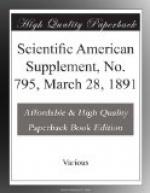I have proved this by taking a small platinum pipe, with a circular loop on the end, the interior of the loop being pierced with minute holes, and by making a circular flame burn within the loop so that the non-luminous zone of the flame just touched the inside of the loop, and then by aspiration so gentle as not to distort the shape of the flame, withdrawing the gases escaping from the outer zone. On analyzing these by a delicate process, which will be described elsewhere, I arrived at the following results:
GASES ESCAPING FROM THE OUTER ZONE OF FLAME.
Luminous. Bunsen.
Nitrogen. 76.612 80.242 Water vapor. 14.702 13.345 Carbon dioxide. 2.201 4.966 Carbon monoxide. 1.189 0.006 Oxygen. 2.300 1.430 Marsh gas. 0.072 0.003 Hydrogen. 2.888 0.008 Acetylene. 0.036 Nil. ------- ------- 100.000 100.000
The gases leaving the luminous flame show that the diluting action of the nitrogen is so great that considerable quantities even of the highly inflammable and rapidly burning hydrogen escape combustion, while the products of incomplete combustion are present in sufficient quantity to account perfectly for the deleterious effects of gas burners in ill-ventilated rooms. The analyses also bring out very clearly the fact that, although the dilution of coal gas by air in atmospheric burners is sufficient to prevent the decomposition of the heavy hydrocarbons with liberation of carbon, and so destroy luminosity, yet the presence of the extra supply of oxygen does make the combustion far more perfect, so that the products of incomplete combustion are hardly to be found in the escaping gases.
These experiments are of the gravest import, as they show more clearly than has ever been done before the absolute necessity for special and perfect ventilation where coal gas is employed for the illumination of our dwelling rooms.
When coal gas was first employed during the early part of this century as an illuminating agent, the low pitch of the old fashioned rooms, and the excess of impurities in the gas, rendered it imperative that the products of combustion of the sulphur-laden gas should be conducted from the apartment, and for this purpose arrangements of tubes with funnel shaped openings were suspended over the burners. The noxious gases were thus conveyed either to the flue or open air; but this type of ventilator was unsightly in the extreme, and some few attempts were made to replace it by a more elegant arrangement, as in the ventilating lamp invented by Faraday, and in the adaptation of the same principle by Mr. I.O.N. Rutter, who strove for many years to direct attention to the necessity of removing the products of combustion from the room. But with the increase of the gas industry, the methods for purifying the coal gas became gradually more and




